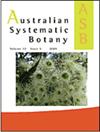The Acrotylaceae (Gigartinales) revisited: molecular data indicate family-level differences in one of the most enigmatic red-algal families
IF 1.5
3区 生物学
Q4 EVOLUTIONARY BIOLOGY
引用次数: 0
Abstract
Abstract. The Acrotylaceae (Gigartinales) has been an obscure, puzzling red-algal family composed of six genera (Acrotylus, Amphiplexia, Antrocentrum, Claviclonium, Hennedya and Ranavalona) that have virtually no habit and vegetative features remotely in common. Excepting Amphiplexia, with two species, all are monotypic and, save for Ranavalona, endemic to the southern half of Australia, Ranavalona being known only by a single collection from southern Madagascar. The most noteworthy unifying feature of the genera is the cystocarps, in which carposporangial filaments grow into a hollow cavity from inner hull layers. In almost all other respects, apart from zonate tetrasporangia, there are no anatomical features that appear uniformly throughout the complex. Molecular studies indicate that the family is composed of the Acrotylaceae sensu stricto (for Acrotylus, Hennedya and Ranavalona) and the newly proposed Clavicloniaceae (for Claviclonium, Amphiplexia and Antrocentrum). We recognise a new species of Acrotylus (A. cryptographicus) and transfer Rhabdonia mollis Harvey and R. hamata Zanardini to Antrocentrum. Closest affinities of both families lie with the Dicranemataceae, Mychodeaceae and Mychodeophyllaceae of the Gigartinales. The South African genus Reinboldia, which is based on a single 19th century collection, has been questionably included in the Acrotylaceae previously but should, in our opinion, be excluded.重游肢端藻科(Gigartinales):分子数据表明最神秘的红藻家族之一的家族水平差异
摘要顶藻科(Gigartinales)是一个晦涩难懂的红藻科,由六个属(顶藻属、两栖藻属、Antrocentrum属、Claviclonium属、Hennedya属和Ranavalona属)组成,它们几乎没有共同的习性和营养特征。除了有两个物种的两栖纲外,所有物种都是单型的,除了澳大利亚南半部特有的拉纳瓦洛纳外,拉纳瓦洛纳只有马达加斯加南部的一个群落。这些属中最值得注意的统一特征是囊果,囊果孢子囊丝从内壳层生长成空腔。在几乎所有其他方面,除了带状的四孢子囊外,没有在整个复合体中均匀出现的解剖特征。分子研究表明,该科由严格意义上的Acrtylaceae(Acrtylus、Hennedya和Ranavalona)和新提出的Claviclonaceae(Claviclonium、Ampiplexia和Antrocentrum)组成。我们识别了Acrotylus(a.cryptographicus)的一个新种,并将Rhabdonia mollis Harvey和R.hamata Zanardini转移到Antrocentrum。这两个科的亲缘关系最为密切的是巨蛋科的Dicranemataceae、Mychodeaceae和Mychodeophyllaceae。南非的Reinboldia属是基于一个19世纪的单一集合,以前曾被怀疑包括在卫矛科中,但在我们看来,应该被排除在外。
本文章由计算机程序翻译,如有差异,请以英文原文为准。
求助全文
约1分钟内获得全文
求助全文
来源期刊

Australian Systematic Botany
生物-进化生物学
CiteScore
3.10
自引率
12.50%
发文量
12
审稿时长
>12 weeks
期刊介绍:
Australian Systematic Botany is an international journal devoted to the systematics, taxonomy, and related aspects of biogeography and evolution of all algae, fungi and plants, including fossils. Descriptive taxonomic papers should normally constitute a comprehensive treatment of a group. Short papers on individual species and nomenclatural papers must contain significant new information of broader interest to be considered. The prestigious L.A.S. Johnson Review Series is published. Other review articles will also be considered. All papers are peer reviewed.
Australian Systematic Botany is published with the endorsement of the Commonwealth Scientific and Industrial Research Organisation (CSIRO) and the Australian Academy of Science.
 求助内容:
求助内容: 应助结果提醒方式:
应助结果提醒方式:


